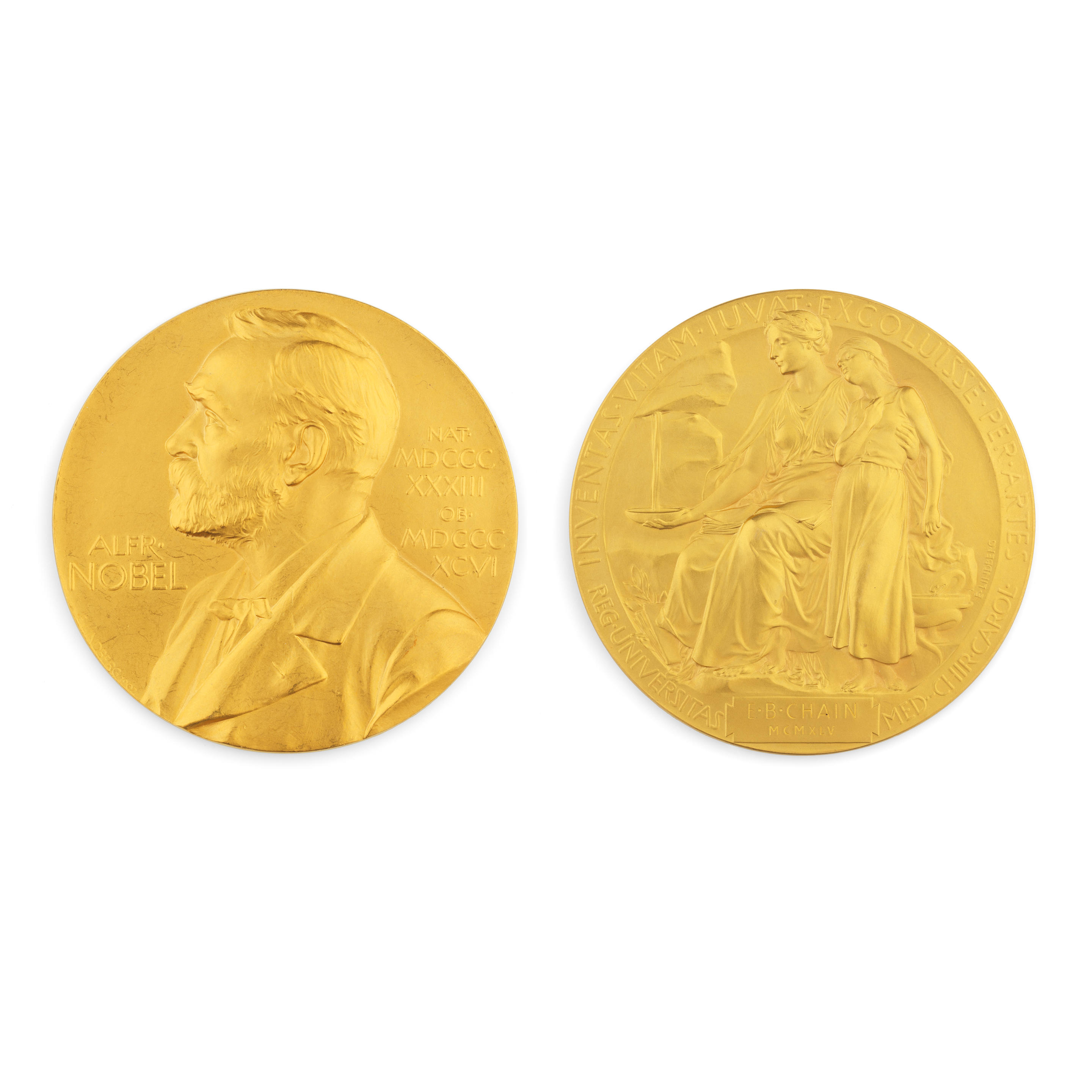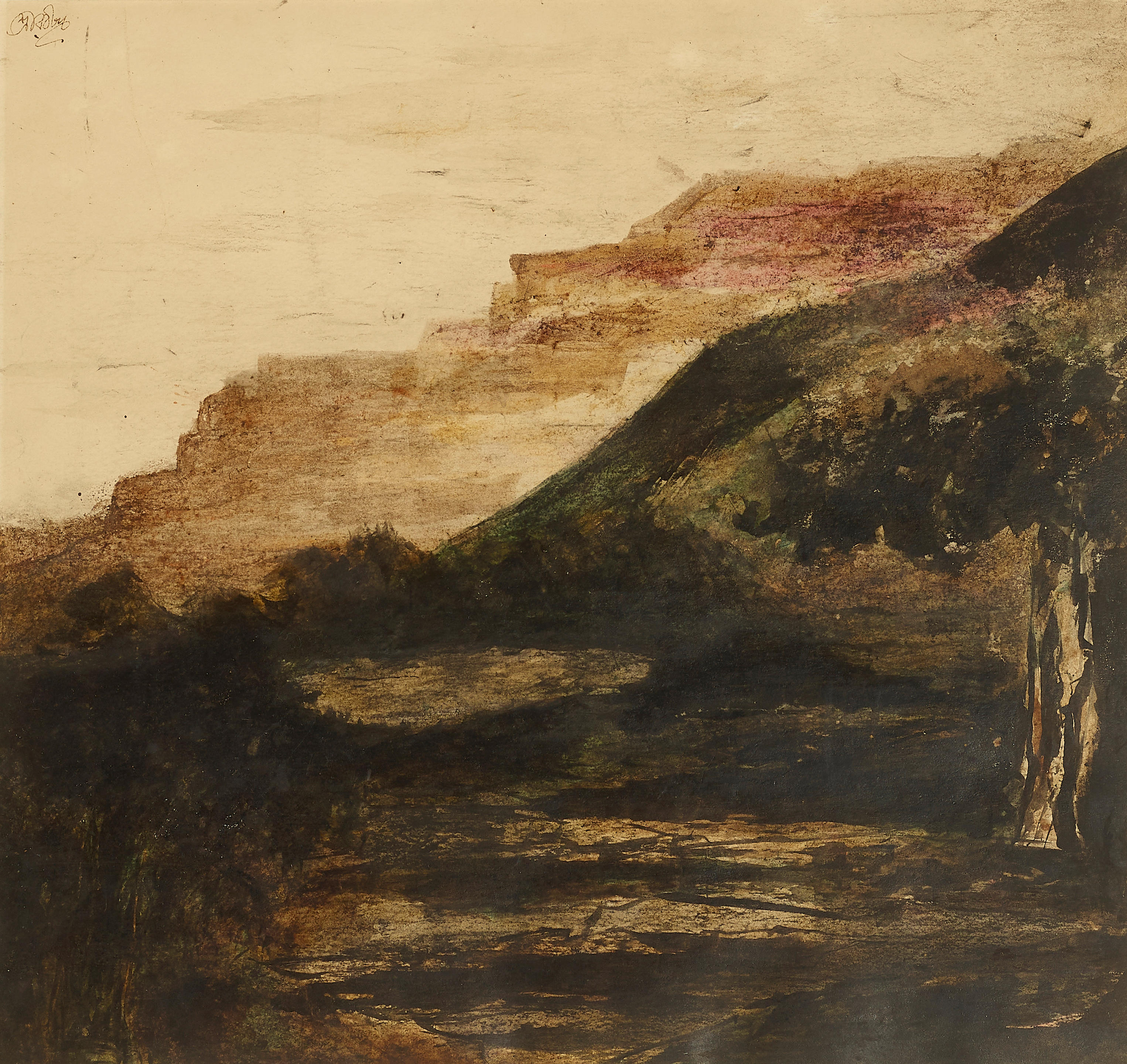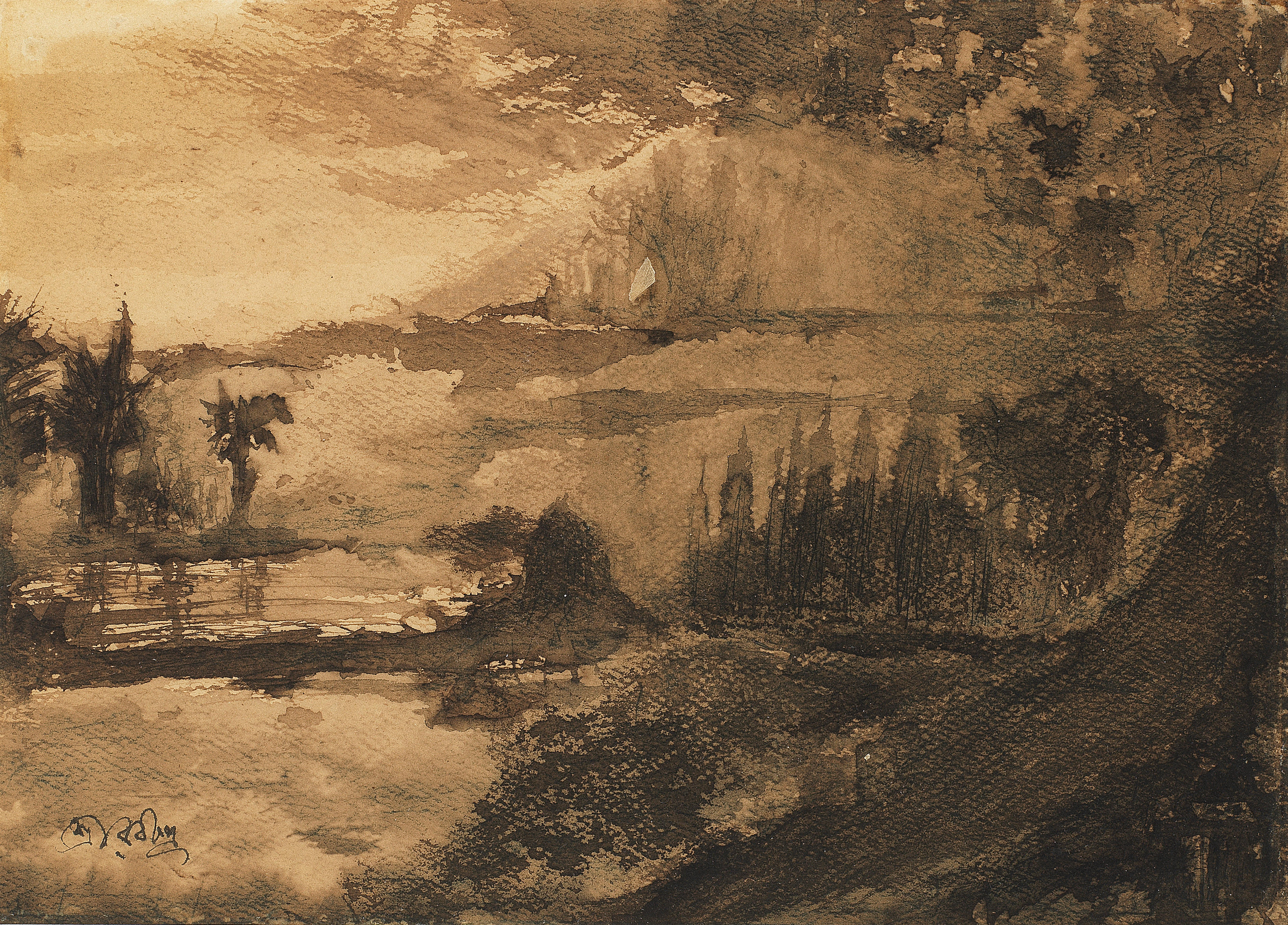Jack Butler Yeats RHA (1871-1957)
Signature: signed lower right; titled and with Dawson Gallery label on reverse
Medium: oil on board
Size: 9 x 14in. (22.86 x 35.56cm) Provenance: Sold by the artist to Victor Waddington, 1944; George Waddington; Adam's, 12 December 1975, lot 24; Private collection; Thomas Adams Blackrock; Where purchased by private treaty by the present owner Exhibited: 'National Loan Exhibition', National College of Art, Dublin, June and July 1945, catalogue no. 131 Literature: Hilary Pyle, Jack B. Yeats: A Catalogue Raisonné of the Oil Paintings, Andre Deutsch, London, 1992, Vol. II, page 569, catalogue no. 624 A man sits alone in a pub. Behind him another customer chats to the barmaid. To the left an open door reveals steep steps leading upwards. The man is dressed in a formal suit, with a black bow tie and hat, the handle of a walking stick rests across h...Read more A man sits alone in a pub. Behind him another customer chats to the barmaid. To the left an open door reveals steep steps leading upwards. The man is dressed in a formal suit, with a black bow tie and hat, the handle of a walking stick rests across his left arm. The fingers of his right hand are extended across the table, tracing its surface, in an unconscious gesture that suggests his introspection. His isolation contrasts with the two figures at the bar and their easy intimacy. The lanky figure of the man leans over the counter and stares intently at the woman. The female figure is dressed in pink and heavily made-up, and, with a shelf of bottles behind her, recalls Edouard Manet's famous and ambiguous Bar at the Folies Bergère. The public house was a significant setting in Yeats' work. Like other liminal spaces associated with modernity such as the railway carriage, the theatre, the tram and the shop, it was a place in which one could survey men and women engaged in social interaction. The interest was not in alcohol but on how this space provided an intimate and familiar setting for its clientele. Some of Yeats' early oils that feature pub interiors include The Railway Bar (1924, Private Collection) and The Bar (1925, Private Collection). In the mid 1940s he painted several interiors of public houses such as Bartender Reading a Letter (1943, Private Collection), The Quiet Man (1943, Private Collection) and Man Reading, (1945, Private Collection). All, like The Man with the Wrinkled Face, are daytime scenes in which patrons and bar staff enjoy the tranquillity of a quiet watering hole. This work is painted in a very distinctive manner that both adds to its narrative quality and conversely foregrounds the materiality of the work. The complex way in which it is constructed invites close scrutiny. The paint is thinly applied in areas, most notably in the depiction of the counter and floor where the pigment has been scrapped back in imitation of wooden boards. The most intriguing part of the work is the face of the wrinkled man. The dense sculptural way in which it has been made makes the right eye appear distorted or immobilised. In contrast to this complexity, the black bow tie stands out as an independent, three-dimensional motif. In trying to resolve these contradictions, the viewer is compelled to see the painting as a painting first and foremost rather than as a legible image. Dr Róisín Kennedy October 2018
Jack Butler Yeats RHA (1871-1957)
Signature: signed lower right; titled and with Dawson Gallery label on reverse
Medium: oil on board
Size: 9 x 14in. (22.86 x 35.56cm) Provenance: Sold by the artist to Victor Waddington, 1944; George Waddington; Adam's, 12 December 1975, lot 24; Private collection; Thomas Adams Blackrock; Where purchased by private treaty by the present owner Exhibited: 'National Loan Exhibition', National College of Art, Dublin, June and July 1945, catalogue no. 131 Literature: Hilary Pyle, Jack B. Yeats: A Catalogue Raisonné of the Oil Paintings, Andre Deutsch, London, 1992, Vol. II, page 569, catalogue no. 624 A man sits alone in a pub. Behind him another customer chats to the barmaid. To the left an open door reveals steep steps leading upwards. The man is dressed in a formal suit, with a black bow tie and hat, the handle of a walking stick rests across h...Read more A man sits alone in a pub. Behind him another customer chats to the barmaid. To the left an open door reveals steep steps leading upwards. The man is dressed in a formal suit, with a black bow tie and hat, the handle of a walking stick rests across his left arm. The fingers of his right hand are extended across the table, tracing its surface, in an unconscious gesture that suggests his introspection. His isolation contrasts with the two figures at the bar and their easy intimacy. The lanky figure of the man leans over the counter and stares intently at the woman. The female figure is dressed in pink and heavily made-up, and, with a shelf of bottles behind her, recalls Edouard Manet's famous and ambiguous Bar at the Folies Bergère. The public house was a significant setting in Yeats' work. Like other liminal spaces associated with modernity such as the railway carriage, the theatre, the tram and the shop, it was a place in which one could survey men and women engaged in social interaction. The interest was not in alcohol but on how this space provided an intimate and familiar setting for its clientele. Some of Yeats' early oils that feature pub interiors include The Railway Bar (1924, Private Collection) and The Bar (1925, Private Collection). In the mid 1940s he painted several interiors of public houses such as Bartender Reading a Letter (1943, Private Collection), The Quiet Man (1943, Private Collection) and Man Reading, (1945, Private Collection). All, like The Man with the Wrinkled Face, are daytime scenes in which patrons and bar staff enjoy the tranquillity of a quiet watering hole. This work is painted in a very distinctive manner that both adds to its narrative quality and conversely foregrounds the materiality of the work. The complex way in which it is constructed invites close scrutiny. The paint is thinly applied in areas, most notably in the depiction of the counter and floor where the pigment has been scrapped back in imitation of wooden boards. The most intriguing part of the work is the face of the wrinkled man. The dense sculptural way in which it has been made makes the right eye appear distorted or immobilised. In contrast to this complexity, the black bow tie stands out as an independent, three-dimensional motif. In trying to resolve these contradictions, the viewer is compelled to see the painting as a painting first and foremost rather than as a legible image. Dr Róisín Kennedy October 2018







.jpg)
.jpg)






Testen Sie LotSearch und seine Premium-Features 7 Tage - ohne Kosten!
Lassen Sie sich automatisch über neue Objekte in kommenden Auktionen benachrichtigen.
Suchauftrag anlegen